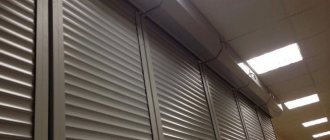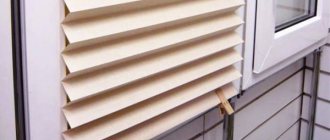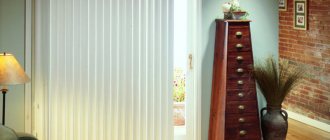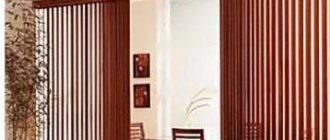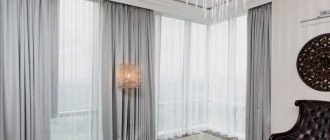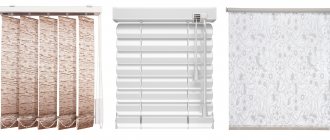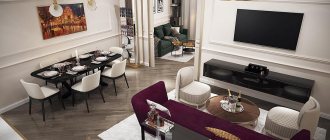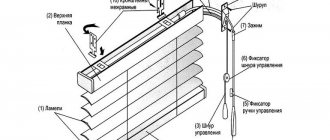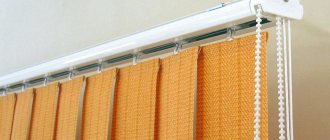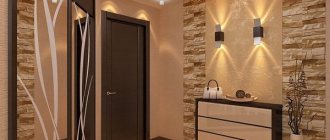Blinds are a worthy alternative to traditional fabric curtains, drapes and drapes. They not only allow you to adjust the lighting of the room, but also serve as an effective addition to the interior. Tips on which blinds you can choose for plastic windows will be useful to everyone.
INTERESTING FACTS!
- Blinds were invented back in the Middle Ages by cunning and jealous men of the East. At home, their wives did not wear a burqa, which meant that passers-by could see the woman’s face through the window. And these curtains let in daylight, leaving the space of the room invisible to prying eyes.
- In 1841, the ingenious invention was refined and patented in England. From that moment on, industrial production and distribution of blinds began in America and European countries.
Which blinds to choose, vertical or horizontal?
There are two options for blinds: horizontal and vertical. They differ in the way the slats are attached and moved.
In the first option, the rotating strips are located horizontally, parallel to the window sill. The width of the lamellas is from 16 mm to 25 mm. Such a curtain can be partially or completely raised to the top of the window frame.
Horizontal blinds are fixed to PVC windows in two ways:
- Hanging: mounted above the window, like ordinary curtains.
- Attic: fixing a plastic window on each sash allows you to open or close the window without interference.
With fastening above the opening
With fastening on each sash
Models with vertical slats are popular among designers for two reasons:
- there is no danger of individual lamellas sagging;
- There are different ways of moving the canvas: it can be moved to one side of the window opening or moved apart from the center of the window to two sides. Modern models are equipped with an electric drive.
The vertical type of blinds sometimes serves as a hanging screen for zoning an apartment or room. To maintain the correct shape, each lamella can be equipped with a lower weight.
Types of wooden blinds
Depending on the material and design, horizontal wooden blinds can look like a canvas made of individual lamellas or like roller blinds made of thin straw fastened together into a single canvas. This straw is not susceptible to ultraviolet radiation, has water-repellent properties and is quite resistant to mechanical damage.
In addition, there is a variety of vertical wooden blinds. It is difficult to combine such blinds with fabric curtains, which is why they are most often used in non-residential premises - recreation rooms, offices, etc. They are very convenient for zoning a room.
Wooden vertical blinds
Classic, roll, cassette or pleated?
Horizontal blinds are divided into several types, each of which deserves attention.
Classic
Horizontal (Venetian) blinds are a classic option. They consist of several dozen thin slats fastened together. Strong cords connect the individual strips in such a way that they can rotate freely around their own axis.
This design has many advantages:
- Stability: the slats are made of dense materials, so the entire system remains motionless even in moderate gusts of wind.
- Aesthetics: a variety of colors allows the product to become a full-fledged decorative element of the interior. Sometimes a pattern is applied to the slats, which is visible in the fully open or closed position (see photo).
- Functionality: Using the controls you can adjust the amount of daylight penetration. Individual lamellas can be in three positions: closed with edges - complete shading, inclined position - partial shading, the planes of the lamellas are strictly parallel to each other - maximum illumination.
- High performance: such curtains are durable, retain their original appearance and shape even with changes in temperature and humidity.
- Hygiene: horizontal blinds do not absorb dust, although they accumulate it on the surface of the slats. Therefore, housewives are advised to wipe the product several times a month with a damp cloth or powder puff, or collect dust with a vacuum cleaner.
A special brush that grips both sides of the lamella at once will help maintain cleanliness. If heavily soiled, you can remove and soak the blinds in a soapy solution. Or, without removing them from the window, spray detergent from a spray bottle on the surface of completely closed blinds. Then rinse with clean water and wipe dry with a rag.
Cassette
This model of light-protection systems is specially created for modern plastic windows and takes into account all their features. Cassette blinds have several advantages over the classic version:
- When the curtain is raised, the curtain is hidden and compactly placed in a small cassette located at the top of the window opening.
USEFUL INFORMATION: Window profiles: types
- A completely retracted canvas opens up the view from the window and does not obstruct the access of sunlight.
- The curtain assembled in a cassette does not get dirty and does not accumulate dust.
- All operations (raising, lowering, rotating the slats) are performed using one chain.
- Side guide strings stabilize the slats when raising/lowering the blade.
Rolled
In roll-up light-protection systems, the main moving part is the fabric sheet.
With the help of control elements, it is wound onto a strong axis, which is located in the upper part of the window opening. By installing and fixing the canvas at a certain height, you can regulate the degree of illumination in the room. All the variety of roller blinds is presented in this article.
Pleated
Pleated blinds are made from specially deformed (smoothed) panels of fabric or thick paper. They are relatively cheap, practical and compact. Can be mounted on window openings of unusual shapes.
Photo printing on blinds
Blinds with photo printing are suitable for people who find plain fabric too boring. Thanks to modern technologies that allow you to apply any design or photograph to the fabric, photo blinds can “change” the view from the window and make the interior exclusive and very individual. To fully appreciate their beauty, the slats need to be unfolded in one line.
Vertical fabric blinds are not only rectangular. They can be given the shape of an arch, cut out like a lambrequin, made beveled blinds for attics and attics, and brilliantly solve the problem of designing windows of non-standard shape. Such versatility makes these unusual curtains very popular and, of course, they deserve your attention.
We select the material (plastic, fabric, wood, bamboo, aluminum)
Plastic blinds are made from PVC or UV polymer. They contain substances that resist exposure to direct sunlight. They are often white, but can have different colors or imitate other materials (natural wood, metal or textiles). Decorators use curtains with photo prints or patterns to decorate rooms.
Aluminum blinds are more durable than plastic sunshade systems. Sometimes the slats are coated with a polymer layer that imitates wood.
Interesting are the perforated aluminum models, which create a pleasant atmosphere in the room. Even with the slats completely closed, they allow some light to pass through the small holes. But you need to keep in mind that the material heats up, so you shouldn’t hang them on the sunny side of the apartment.
Beautiful fabric blinds, reminiscent of ordinary curtains, are made of polyester, jacquard or fiberglass. Compared to plastic or aluminum, they have wider lamellas, impregnated with compounds that repel moisture and dirt, and increase resistance to fading.
The very first models of horizontal blinds had wooden slats ranging from 3 cm to 15 cm in width. The individual lamellas were connected and assembled together using ropes or narrow ribbons. Wooden models are highly valued by decorators. These light-protection systems add solidity to any room, be it a living room or a bedroom, and go well with furniture and small design elements.
Wooden slats are coated with compounds that protect them from destruction and fading. Blinds made of this material can only be maintained dry (sweep or wipe with a brush).
Light and thin light-protection systems made of bamboo are compact and take up very little space when folded. Bamboo slats allow light to pass through even in a completely closed (strictly vertical) position. The golden yellow color creates the illusion of a sunny day indoors.
But it is undesirable to use systems made of this material to cover large window openings. Bamboo is elastic, which means the slats can bend under their own weight.
USEFUL INFORMATION: How to choose a profile for plastic windows: number of chambers, width, manufacturer ratings
Types of blinds according to the material used to make the slats
According to the material from which the slats are made, blinds are:
- Metal.
- Plastic.
- Wooden.
- Fabric.
Each type has pros and cons, but they are all characterized by aesthetics, practicality, and ease of care. To clean, simply wipe the slats from dust with a damp cloth and detergent.
Blinds made from certain materials are suitable for different rooms. In the kitchen, it is better to use aluminum or plastic blinds, provided that the latter are not located near the stove. Wooden structures look chic in living rooms, fabric ones in bedrooms. In wet rooms - bathrooms and showers - if they have windows, it is better to use waterproof plastic models.
Pros and cons of metal (aluminum) blinds
Metal blinds are made of aluminum. Aluminum structures are characterized by increased strength and durability. The slats can be oriented vertically or horizontally, matte or glossy, in a natural metallic color or painted in a range of RAL colors.
Metal blinds.
Advantages of aluminum blinds
- Temperature resistance. Unlike plastic models, metal ones can be installed near an open fire: in the kitchen near a gas stove, radiators, heating boilers.
- Do not fade under the influence of UV rays.
- Light weight. Aluminum structures are somewhat heavier than plastic or fabric ones, but nevertheless they are lightweight.
- They have good resistance to wind loads. When the windows are open, they retain their shape and do not flutter or flutter like lighter fabric or plastic products.
- Increased strength. Metal strips are convenient because they do not tear, break, or burn.
- Fire safety. Today this is an important factor for consumer goods, when the market is filled with synthetic materials that release toxic substances when burned.
- Easy to care for. The metal does not absorb grease and does not change its appearance during use. To clean, simply rinse the slats with water and ordinary detergents.
- Durability. When used correctly, they last longer than other types of blinds.
- Excellent aesthetic properties. Metal structures are relevant in interiors decorated in hi-tech, modern, and loft styles.
Cons of aluminum blinds
- Metal has high thermal conductivity, so window structures heat up in summer when exposed to direct sunlight.
- When there are strong gusts of wind, they produce a characteristic metallic knock when the slats hit each other.
Aluminum products meet sanitary and hygienic requirements, therefore they are widely used in medical institutions, clinics, and for decorating cafes and restaurants.
Advantages and disadvantages of plastic blinds
Plastic window blinds are made from PVC in white or painted in RAL colors. Plastic blinds are in demand by customers. They are practical, the color range is rich, and their price is low. Plastic blinds are cheap, so they can be replaced frequently.
Plastic blinds.
Advantages of plastic blinds
- They are inexpensive.
- Many colors. Manufacturers offer a huge number of canvas colors - calm pastel shades, bright colors, stylized like wood, metal, stone.
- Plastic is practical, hygienic, and easy to care for.
- Plastic slats are not afraid of moisture, so they are used in rooms with high humidity - saunas, bathrooms, shower rooms, toilets, and kitchens away from open fire.
- They serve for a long time without losing their appearance and do not deteriorate.
- Suitable for any interior - residential building, apartment, cottage or office.
- Pairs well with fabric curtains and tulle curtains.
Cons of plastic blinds
- Not resistant to heat. When strongly heated by the sun's rays in the summer heat, the plastic softens, the geometry of the canvas is disrupted, and the products lose their shape. Therefore, they cannot be installed near heat sources: stoves, ovens, radiators, fireplaces.
- Colored lamellas fade over time in the sun, white ones turn yellow over time.
- Plastic is more fragile compared to other materials; the lamellas bend and sometimes break. If there are animals in the house, they can chew through thin plates.
Despite some disadvantages, this is the most suitable type of blinds for plastic windows. The plastic option is suitable for an office, temporary housing or bachelor's apartment. Plastic products are inexpensive, easy to care for, and can be easily replaced when you get tired of them or break down. The designs are organically combined with fabric curtains and look neat without them.
Advantages and disadvantages of wooden blinds
Wooden blinds are often made from exotic woods - bamboo, balsa wood, Canadian linden. Natural material is more expensive, so prices are higher. Wood creates a special atmosphere in the house. This is a natural material, its presence in the interior is considered a sign of the owners’ good taste, high status, and respectability. The slats of wooden blinds are made of light species - bamboo, cork.
Wooden blinds.
Advantages of wooden blinds
- These are environmentally friendly designs that do not cause allergic reactions and do not emit harmful fumes.
- Wood is a beautiful and prestigious natural material. It gives the room a respectable appearance and solidity.
- They do their job well, protecting rooms from sunlight.
- Unlike metal structures, wooden ones do not overheat when exposed to direct sunlight.
- The lamellas have increased strength and dimensional stability.
- Wood planks are durable. The service life of wood is much longer than that of plastic models.
- Easy to care for. There are special devices for manual cleaning of slats.
- Wood has a low thermal conductivity coefficient, so wooden structures are warm to the touch.
- They look great in the interior, combined with furniture, especially solid wood.
Cons of wooden blinds
- Non-moisture resistant. The lamellas swell under the influence of moisture and water.
- Prices for wooden models are high.
New types of wooden structures made from valuable wood species are constantly appearing on the market.
Pros and cons of fabric blinds
They are made from fabrics with impregnations that repel dirt, dust, and water. They are easy to clean, inexpensive, and create comfort in the home. Fabric blinds only come with vertical slats. More often, slats are made of synthetic fabrics impregnated with water-repellent compounds - polyester or fiberglass. Sometimes cotton, jacquard, linen, and viscose are used to make them.
Fabric blinds.
Pros of fabric blinds
- Create comfort in the room. Fabric is a traditional material for window decoration, so fabric curtains are well received by residents and guests.
- Light in weight, unlike metal or wooden structures.
- They are easy to care for due to the presence of dirt-repellent impregnations in the fabric.
Cons of fabric blinds
- Compared to wood, plastic or aluminum systems, they are less durable.
- Due to their light weight, they are blown by the wind when the windows are open - the canvas “quivers”.
- The color variety is less than that of plastic structures, although quite large.
The fabrics vary in color and texture. Fabric blinds are more suitable for living rooms, bedrooms, studios, and dining rooms, but they are less often used in kitchens. The standard height of fabric slats is 180 cm, they can be shortened to fit the height of the window. To change the length of the strip, just remove the weighting material from the lower end and cut the fabric. Then you need to make a pocket at the bottom where you can insert the weighting material.
Tips for choosing blinds for different rooms
To choose blinds, in addition to appearance, you need to pay attention to several important parameters, which include:
- Design. The area of space required for installation will depend on it.
- Control type. Manual (mechanical) control using a rotating cane and rope is used in blinds installed on small windows. For large structures, it is convenient to use automatic control using an electric motor, which is activated by a button on the remote control. The most modern models are controlled remotely and equipped with light-sensitive sensors and timers.
- Model weight. The stronger the supporting structure, the heavier the blinds can be.
- The number of positions in which the slats can be fixed.
- Environmental friendliness - the level of noise generated, the absence of harmful additives released into the air.
- Aesthetics – resistance to fading, deformation of individual lamellas, duration of preservation of the original shape of the product.
Examples in the interior of rooms
Vertical blinds are used in all types of premises. The main thing is to choose the right material and style of the product.
Kitchen
In a small kitchen with a low ceiling, vertical models will visually increase the space, and thanks to their practicality, they will fit perfectly into the interior and become a stylish and comfortable decor.
See also how blinds look in the kitchen interior.
The photo shows a kitchen with window openings decorated with vertical slats in a soft blue color.
Living room
When choosing, the first thing to consider is the interior design. These can be absolutely any vertical blinds that will not stand out from the overall style of the room and will further emphasize its exceptional appearance.
The photo shows a fusion style living room and light vertical blinds on the windows.
Bedroom
Fabric designs in soothing pastel colors are perfect here. They will add weightlessness, airiness and lightness to the interior.
Look at the blinds in the bedroom interior.
Children's
In the nursery, eco-friendly models made from natural materials are used. Vertical blinds will protect the room from bright light and provide comfortable daytime sleep for your child.
Toilet
Blinds in the bathroom are used as window decoration if the toilet has this opening. In addition, lamellas are used as an element with which you can hide and disguise plumbing pipes.
Balcony and loggia
Vertical slats located along the entire length of the plastic balcony window look like one continuous canvas and thereby give integrity to the entire space.
To the bedroom
The bedroom is a place of rest and relaxation, where there should be no harsh tones, loud or unpleasant sounds. Therefore, practically silent fabric blinds (roller, pleated) of horizontal and vertical designs are most appropriate here.
Models made from natural materials (cotton, jacquard) are suitable for the bedroom. Often fabric slats are impregnated with a special solution, which makes the fabric completely impenetrable to light.
Rolled fabric
Vertical fabric
Advice from Mr. Build: for a bedroom in Provence, shabby chic, country, or eco-style, we recommend choosing wooden blinds. For a room in a minimalist or Japanese style - made of bamboo.
Why should you choose them?
The products were previously considered more of an office option, but in recent years they have become more popular in private homes and apartments in a modern style.
They have many benefits for your windows. Reflective materials with anti-reflective coating are ideal for home and office use. Practical blackout fabrics are a universal solution for the bedroom.
The scope of application is quite wide. They are used not only to regulate the amount of light in a room, but also as a solution to technical problems - to close a niche or an unsightly opening; they often serve as partitions in the office.
Use curtains to give the room a casual feel
An interesting, soft, layered look can be created by pairing fabric vertical blinds with curtains in a more traditional setting.
To the kitchen
Practical horizontal blinds made of plastic are suitable for the kitchen: they do not absorb odors, are not afraid of humidity and temperature changes, and are easy to clean.
If you want an interesting color and texture, you can choose a fabric option. Due to impregnation, such blinds will not absorb odors, grease and moisture. And curtains with photo printing can become the main accent of the kitchen.
Aluminum models are appropriate in a high-tech kitchen. But we must not forget that they heat up in the sun and rattle in a draft.
You can save space on the kitchen window sill by installing cassette blinds, which are completely assembled into the upper cassette.
The classic white color of the blinds allows you to notice and remove dirt in a timely manner and harmonizes with kitchen appliances and furniture. This design looks neat and fresh and perfectly complements modern styles: minimalism, contemporary, Scandinavian.
How to care for fabric blinds
Caring for fabric blinds comes down to cleaning the slats and wiping the cornice. Regular cleaning is carried out 1-2 times a month with a dry cloth, broom or vacuum cleaner.
Slats with a smooth surface just need to be wiped with a soft cloth. For embossed stripes, you will have to purchase a broom, since the rag will drive dust into the embossed surface, and it will only become dirtier. The most effective way to clean blinds is with a vacuum cleaner. This should be done using a delicate suction mode with a clean, preferably separate, brush.
You need to take care of your blinds even when they don't look dirty. If you do this regularly, it is likely that they will not need time-consuming major cleaning for very long.
If the blinds look untidy, stains have appeared on them and they will have to be dry cleaned or washed. Machine washing is not recommended. Even the most delicate machine mode can damage the slats. Therefore, you will have to wash the blinds manually. The sequence of actions is as follows:
- 1 Remove the slats from the cornice, take out the weights from them, roll 3-4 pieces into rolls and place them in laundry bags. The size of the bags should not allow the slats to unfold.
- 2 The filled bags are placed in a container with soapy water, the temperature of which does not exceed 30-40 °C, allowed to soak for half an hour, then lightly shaken several times and rinsed thoroughly.
- 3 The washed slats are dried without squeezing, on a rope, inserting weights into them and securing them with clothespins. Heating devices cannot be used for drying - when heated, the lamellas may warp.
In hand washing conditions, it is very difficult to rinse out ordinary powder from the lamellas, so it is better to use gel, shampoo or soap solution. If only a few lamellas are dirty, they can simply be replaced with new ones.
For a loggia or balcony
For a loggia, which often serves as a complete and cozy room for work or relaxation, there are also rules for selecting blinds.
- For aluminum and sliding frames, only hinged structures are suitable, preferably with vertical slats. For casement windows, choose horizontal models with sash mounting.
- For the south side it is better to choose curtains made of thick fabric; for the north side, light translucent designs are suitable.
- On a small balcony, short models with an attic type of fastening look better.
- Curtains with wooden slats are combined with plants and outdoor furniture, are resistant to gusts of wind, create a comfortable environment, and fit into any style.
USEFUL INFORMATION: Window in the bedroom: decoration and design
- Bamboo blinds are good for a balcony in eco- or ethnic style, chalet, oriental.
Fabric roller blinds
Although this type of window decoration is classified as blinds, the fabric of the roller blinds does not consist of individual slats. This is a continuous piece of fabric that, when lifted, is rolled into a roll. The fabric for such blinds undergoes special processing, due to which the fabric acquires dust-repellent, fire-resistant and moisture-resistant properties.
Classification of fabric roller blinds:
1. Roll mechanism type:
- open - the canvas, rolled into a roll, remains in sight;
- closed - the canvas is hidden in a plastic box (another name for such blinds is cassette);
2. Availability of guides:
- Mini – without guides;
- Uni - with vertical guides that fix the canvas, forcing it to move close to the window;
3. Fabric type:
- transparent;
- translucent;
- lightproof (“blackout”);
- with an image;
- with photo printing;
- “zebra” (double fabric with vertical alternating transparent and opaque stripes; the arrangement of the stripes relative to each other allows you to adjust the level of light transmission of the blinds).
Methods for installing fabric roller blinds:
- Roller fabric blinds can be mounted on plastic windows by securing them to the sash with self-tapping screws.
- Opening flaps allow you to fix the blinds using L-shaped plastic hooks, that is, without drilling.
- The blind structure is often glued to blind sashes with a special foam tape.
Are you choosing cassette blinds for plastic windows?
Read my tips and recommendations for choosing the type of blinds and find out how much they should cost in Moscow. I highly recommend that you familiarize yourself with Izolight blinds - they are very convenient and functional - they are mounted directly on the window sash, thereby not taking up space on the windowsill, read more →
How to choose the right size blinds for plastic windows
The dimensions of the product will depend on the method of fastening the light protection system.
Horizontal
Dimensions for horizontal models:
- For a window sash: the width of the blinds should be 30 mm less than the width of the glass, and their length should be 1.5–2 cm shorter than the height of the window opening.
- In the window opening: the dimensions of the blinds are the same as in the first option, but you need to take into account the protruding upper cornice of the structure, which can rest against the slopes. Openings are not always level, so it is better to take measurements at several points.
- Instead of a window cornice, on the wall: the width of the structure is 10–15 cm wider than the window opening, the length is arbitrary.
Horizontal systems can be mounted in a hinged manner, covering the entire window opening. And in order to completely free up the window sill space, you need to install them using drilling on each window sash. It is desirable that the model have a side hole, and the individual lamellas are fastened with a metal string or nylon fishing line. Such fastening will tightly tension the canvas on the sashes and prevent unnecessary movements (chattering) of the slats when opening/closing the window.
Advice from Mr. Build: you should not buy or order horizontal blinds with slats longer than 2 meters. Such long strips begin to bend under their own weight. Often, for horizontal structures, a lower clamp is installed, which prevents the blinds from sagging.
The side fixation of cassette horizontal blinds is much neater, making it almost invisible. The canvas of this model fits tightly to the glass, which ensures more complete and reliable protection from light.
Vertical
Dimensions of the vertical structure:
- In a window opening: subtract 2 cm from the width of the opening, and 1 cm from the length. These will be the dimensions of the mounted curtain.
- In place of the cornice, on the wall: the width of the product should exceed the width of the window opening by 10–15 cm, the length should be arbitrary. But a window sill covered with blinds looks more aesthetically pleasing.
- On the ceiling: the length is chosen arbitrarily (to the window sill or almost to the floor), the width of the blinds is 10–15 cm greater than the width of the window opening.
Vertical blinds are rarely used for small windows: wide slats (89–127 mm) are located close to the glass, which makes them difficult to rotate.
Technical characteristics and photos in the interior: vertical fabric blinds
Vertical blinds are based on an aluminum profile. Fabric slats are already attached to it. Their width may vary. If these are American-type lamellas, then their width is 89 mm. The European standard will be wider – 127 mm. And sometimes the profile of the blinds can be curved, arched, or under a bay window.
Features of vertical blinds:
- A decorative cornice can be attached to the profile on top using special brackets - it closes the gaps between the slats and the top of the blinds;
- The control mechanism of the blinds can be either on the left or on the right; to move the slats you need to use a rope, and to turn the slats around their axis - a special control chain;
- To keep the blinds safe, the slats should only move when open.
There are, of course, electrically operated fabric blinds. Remote control is very convenient, but it is not cheap. That’s why rope blinds are more common and affordable.
Which blinds are better? Manufacturers rating
The rating of manufacturers of light protection systems, compiled on the basis of customer reviews, will help you make the right choice. Users rated the blinds based on their price/quality ratio.
- "Cosiness".
- "Escar."
- Sunlight.
- Gira.
- Kauffort.
- Isolit.
- "Verend-Design".
- Redi Shade.
- JANG.
- Penie.
Types of blinds for apartments
Vertical
Thanks to vertically positioned slats, which are attached to the cornice using special holders, blinds of this type resemble conventional curtains.
They go perfectly with large windows and fit perfectly into arches and bay windows. Vertical blinds are attached to the ceiling or wall, or placed inside the window opening.
The control mechanism allows you to rotate the slats 180° around their axis. By changing the angle of rotation of the lamellas, the degree of illumination of the room is adjusted. Similar to curtains, blinds can be moved and pulled apart along the window opening; a special cord is used for this purpose.
Advantages:
- The ability to create a single ensemble with curtains;
- Visually increase the height of the window and room;
- To a lesser extent than horizontal models, they are deformed by wind and when heated;
- Possibility of replacing individual structural elements.
Flaws:
- The noise effect that occurs when the blinds sway in the wind and when they come into contact with the window sill.
Horizontal
Horizontal blinds, as a rule, are installed on small window openings, and the structure is mounted on the surface of the window frame. By pulling the cord, the blinds are lowered or raised. And by changing the angle of the slats, they regulate the flow of light entering the room.
Advantages:
- Low price;
- Expanded scope of application (installed not only on windows, but also on doors with double-glazed windows, openings, as well as inside pavilions made of double-glazed windows);
- Easy adjustment of light intensity;
- Mounting on a window frame makes it possible to use blinds together with curtains and drapes (they serve a practical function, while the curtains are a decorative element);
- The use of special brackets allows you to install blinds on the window frame without drilling holes.
Flaws:
- The need for regular maintenance, as more dust accumulates on horizontal surfaces;
- When attaching blinds to a window frame without using special brackets, there is a risk of damaging the glass unit. After dismantling the blinds, holes remain on the surface of the frame.
Rolled
In roller blinds, instead of slats, a polymer or fabric canvas is used, which, thanks to a special mechanism, is rolled into a roll at the top of the window.
Roller blinds can have the following types of design:
1. Mini - have the simplest device: an open box, without guides or weights. Opens from bottom to top.
2. UNI-1 – cassette blinds, in which the canvas moves along side guides and opens from bottom to top.
3. UNI-2 – improved cassette blinds with the ability to be installed at the bottom of the window (they open from top to bottom). Made from two types of fabric of different densities, which allows you to adjust the level of lighting in the room.
Advantages:
- Combined with curtains and curtains, this is the most “homey” version of blinds;
- Possibility of fixing the canvas at the desired level;
- Can be installed on any type of window (with frames made of plastic, wood);
- Possibility of photo printing on canvas.
Flaws:
- At home, removing stains is difficult, since you cannot scrub them off in the usual way, and strong chemicals can damage the fabric. It is advisable to entrust stain removal to dry cleaning professionals;
- They do not tolerate wet cleaning well.
Pleated
Pleated blinds are the most aesthetic way to decorate a window opening. They go well with plastic windows. Often, only pleated blinds are installed on the window.
If necessary, they can be supplemented with the usual curtains, with which they combine perfectly (subject to the correct selection of colors).
Advantages:
- Easy to attach (using double-sided tape);
- The designs can be for windows of any type: vertical, horizontal, arched, as well as any non-standard shape, including roof windows;
- Not prone to sagging even after a long period of use due to the tension of special cables;
- Ability to move and move individual folds;
- They look harmonious when installed with regular curtains, giving a homely feel to the room;
- Thanks to special processing of the material, the blinds do not attract dust;
- They do not fade in the sun and are not deformed at high temperatures.
Flaws:
- Curtains can only be cleaned with delicate hand washing;
- Compared to other types of blinds, they have a relatively high price.
How much do blinds cost?
The cost of specific models of blinds is influenced by the price of the material from which the slats are made (type of wood, type of plastic, quality of fabric), and the complexity of the control mechanism (type of control).
| Blinds model | Price per 1 m², rub. |
| Horizontal plastic | 230–2000 |
| Cassette | 500–2000 |
| Aluminum | 350–800 |
| Rolled | 400–1500 |
| Pleated | 600–3000 |
| Wooden | 950–4500 |
| Bamboo | 860–4000 |
| Vertical fabric | 350–2000 |
Custom-made blinds can be of unusual shape, combine several materials (multi-texture) or colors.
Sometimes an original drawing (photo print) is applied to them. Roller blinds are embroidered with silk, gold thread, beads, and decorated with a graphic pattern or ornament.
Slats for vertical blinds
Vertical slats are slats that form blinds. These vertical stripes are made from 4 materials: plastic, metal, wood and fabric. They are hung in spacious rooms, as they are more bulky than horizontal ones.
The plastic type is the most common, it is the most hygienic and safe, and also has low prices. Wood and metal are less popular materials due to their heaviness. However, their advantage is that they wear out more slowly and rarely break.
They are usually installed in spacious office spaces. Wooden blinds are purchased for special types of interiors (Provence, country, retro). Fabric slats are linen, jacquard, cotton and others. It happens that the lamellas are combined into a pattern.
Don't panic if one of the slats breaks - you can buy them individually. Experts advise that instead of replacing one lamella, change several. This way the contrast between the old and new slats will be less noticeable, and the fresh part will not stand out too much.

